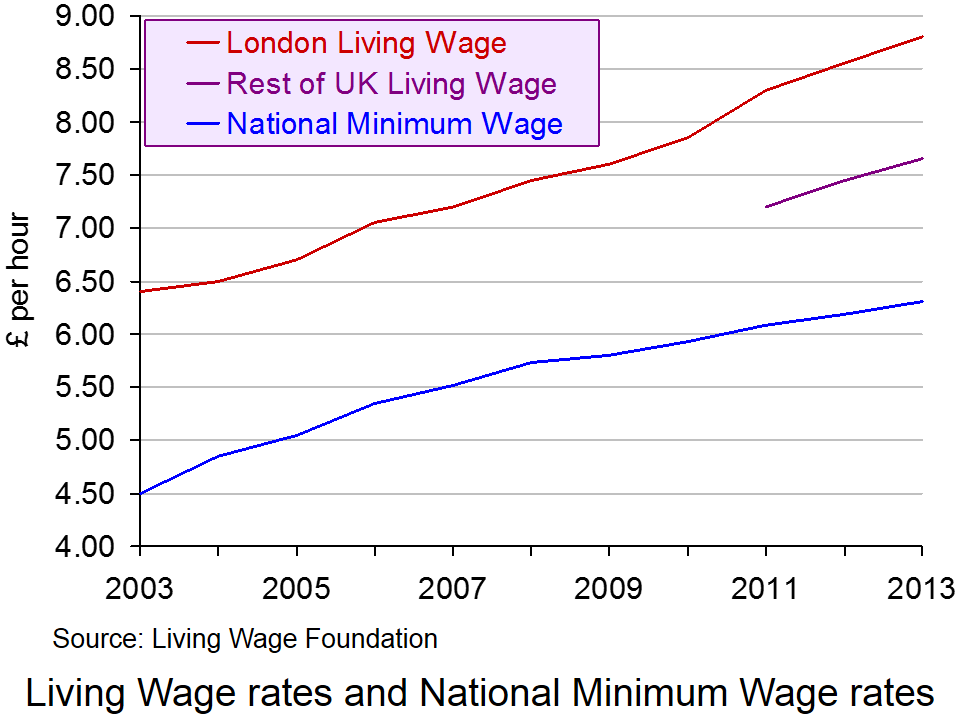 Each year in November, the Living Wage Foundation publishes figures for the hourly living wage that is necessary for people to meet basic bills. The rate for London is calculated by the Greater London Authority and for the rest of the UK by the Centre for Research in Social Policy at Loughborough University.
Each year in November, the Living Wage Foundation publishes figures for the hourly living wage that is necessary for people to meet basic bills. The rate for London is calculated by the Greater London Authority and for the rest of the UK by the Centre for Research in Social Policy at Loughborough University.
The 2013 update was published on 4 November. The Living Wage was estimated to be £8.80 in London and £7.65 in the rest of the UK.
Two things need to be noted about the Living Wage rate. The first is that the figure is an average and thus does not take into account the circumstances of an individual household. Clearly households differ in terms of their size, the number of wage earners and dependants, the local costs of living, etc. Second, the figures have been reduced from what is regarded as the ‘reference’ living wage, which is estimated to be £9.08 outside London. The reason for this is that people earning higher incomes have seen their living standards squeezed since 2009, with prices rising faster than average post-tax-and-benefit wages. Thus, the Living Wage is capped to reflect the overall decline in living standards. As the Working Paper on rates outside London explains:
From 2012 onwards, two kinds of limit have been put on the amount that the Living Wage as applied can rise in any one year. The first limits the increase in the net income (after taxes and benefits) requirement for each household on which the living wage calculation is based, relative to the rise in net income that would be achieved by someone on average earnings. The second limits the increase in the living wage itself (representing gross income) relative to the increase in average earnings.
 Nevertheless, despite this capping of the living wage, it is still significantly higher than the UK National Minimum Wage, which currently stands at £6.31 for those aged 21 and over. This can be seen from the chart (click here for a PowerPoint).
Nevertheless, despite this capping of the living wage, it is still significantly higher than the UK National Minimum Wage, which currently stands at £6.31 for those aged 21 and over. This can be seen from the chart (click here for a PowerPoint).
Paying the Living Wage is voluntary for employers, but as The Guardian reports:
A total of 432 employers are now signed up to the campaign, up from 78 this time last year, including Legal & General, KPMG, Barclays, Oxfam, Pearson, the National Portrait Gallery and First Transpennine Express, as well as many smaller businesses, charities and town halls. Together they employ more than 250,000 workers and also commit to roll out the living wage in their supply chain.
But as The Observer reports:
The number of people who are paid less than a ‘living wage’ has leapt by more than 400,000 in a year to over 5.2 million, amid mounting evidence that the economic recovery is failing to help millions of working families.
A report for the international tax and auditing firm KPMG also shows that nearly three-quarters of 18-to-21-year-olds now earn below this level – a voluntary rate of pay regarded as the minimum to meet the cost of living in the UK. The KPMG findings highlight difficulties for ministers as they try to beat back Labour’s claims of a “cost of living crisis”.
According to the report, women are disproportionately stuck on pay below the living wage rate, currently £8.55 in London and £7.45 elsewhere. Some 27% of women are not paid the living wage, compared with 16% of men. Part-time workers are also far more likely to receive low pay than full-time workers, with 43% paid below living-wage rates compared with 12% of full-timers.
But although paying a living wage may be desirable in terms of equity, many firms, especially in the leisure and retailing sectors, claim that they simply cannot afford to pay the living wage and, if they were forced to, would have to lay off workers.
The point they are making is that it is not economical to pay workers more than their marginal revenue product. But this raises the question of whether a higher wage would encourage people to work more efficiently. If it did, an efficiency wage may be above current rates for many firms. It also raises the question of whether productivity gains could be negotiated in exchange for paying workers a living wage
These arguments are discussed in the following podcast.
Podcast
 Higher ‘productivity’ will increase living wage BBC Today Programme, Priya Kothari and Steve Davies (4/11/13)
Higher ‘productivity’ will increase living wage BBC Today Programme, Priya Kothari and Steve Davies (4/11/13)
Articles
UK living wage rises to £7.65 an hour The Guardian (4/11/13)
More than 5 million people in the UK are paid less than the living wage The Observer, Toby Helm (2/11/13)
Increasing numbers of Scots are paid less than living wage Herald Scotland (2/11/13)
Labour would give tax rebates to firms that pay living wage Independent, Jane Merrick (3/11/13)
Employers praise Ed Miliband’s living wage proposal Independent, Andy McSmith (3/11/13)
Miliband’s living wage tax break will raise prices, warns CBI chief The Telegraph, Tim Ross (3/11/13)
Living Wage rise provides a boost for low paid workers BBC News (4/11/13)
Information and Reports
What is the Living Wage? Living Wage Foundation
The Living Wage Centre for Research in Social Policy, Loughborough University
Living wage Mayor of London
One in five UK workers paid less than the Living Wage KPMG News Release (3/11/13)
Number of workers paid less than the Living Wage passes 5 million KPMG News Release (3/11/13)
Living Wage Research for KPMG Markit (October 2012)
Questions
- How is the Living Wage calculated?
- What are the reasons for announcing a Living Wage figure that is lower than a reference living wage? Assess these reasons.
- If there are two separate figures for the Living Wage for London and the rest of the UK, would it be better to work out a living wage for each part, or even location, of the UK?
- Why might it be in employers’ interests to pay at least the Living Wage? Does this explain why more and more employers are volunteering to pay it?
- Assess the Labour Party’s pledge, if they win the next election, that ‘firms which sign up to the living wage will receive a tax rebate of up to £1000 for every low-paid worker who gets a pay rise, funded by tax and national insurance revenue from the higher wages’.
- Which is fairer: to pay everyone at least the Living Wage or to use tax credits to redistribute incomes to low-income households?
 Imagine if none of the clubs in the English Premier League (EPL) or English Football League (EFL) had junior or youth teams. Instead envisage a situation where all of the talented young footballers in the country go to college or university to develop their skills. Then once a year there is a big televised event where each of the clubs in the EPL and EFL take it in turns to choose which young college/university players they would like to recruit.
Imagine if none of the clubs in the English Premier League (EPL) or English Football League (EFL) had junior or youth teams. Instead envisage a situation where all of the talented young footballers in the country go to college or university to develop their skills. Then once a year there is a big televised event where each of the clubs in the EPL and EFL take it in turns to choose which young college/university players they would like to recruit.
Strange as it sounds to football fans in Europe this is exactly what happens in American Football in the USA. It is called the NFL draft and this year’s event took place over three days between 25th and 27th April at Radio City Music Hall in New York. There was greater interest in Britain than usual in this year’s event because of the involvement of 24 year old Menelik Watson who was born and raised in Manchester. Although originally a basketball player, coaches spotted his potential to play American football in the NFL and two years ago he obtained a place at Florida State University.
The NFL draft has seven rounds. Each of the 32 teams has the right to choose one player in each round. An important design issue for any draft system is how to determine the running order in which the teams make their choices. Obviously all 32 teams would like to get the first chance at recruiting the most talented of all the college players. The NFL’s solution to this allocation problem is an interesting one. The team with the worst playing record from the previous season gets the first choice in each round. In the 2012-13 season this happened to be the Kansas City Chiefs who played 16 games and only won 2 of them. The second choice in each round goes to the team with the 2nd worst playing record from the previous season and so on. The final choice in each round goes to the previous year’s Super Bowl champions who in the 2012–13 were the Baltimore Ravens. Another interesting characteristic of the system is the ability of teams to trade draft choices. For example in 2013 the Oakland Raiders traded their choice in the first round (which was the 3rd choice overall) with the Miami Dolphins for their choices in both the first and second round (12th and 42nd choice overall).
What is the rationale for having a draft system? It was first introduced in February 1936 and many commentators have argued that it has been a key factor which has helped to maintain competitive balance in sport. The man behind the idea, Bert Bell of the Philadelphia Eagles, argued that without this type of system the sport would be dominated by the 4 richest teams. He stated that:
Every year, the rich get richer and the poor get poorer. Four teams control the championship. Because they are successful, they keep attracting the best college players in the open market, which makes them more successful.
Some evidence for the success of the scheme is that in the last 15 years the Super Bowl has been won by 10 different teams. However in 1934, just before the scheme was proposed, there was another major issue for team owners. The Brooklyn Dodgers and the Philadelphia Eagles had become involved in a bidding war for a very talented young player called Stan Kostka. Brooklyn won the battle but had to pay him a salary of $5,000 – the same amount that was paid to the star player in the league. Some people have argued that the real purpose of the draft scheme was to limit the pay of young players by effectively reducing any competitive bidding for their services. Once drafted, a player is expected to join the team who selected him. There may be some protracted negotiations over his final salary and bonuses but the only option open to him if an agreement breaks down is to re-enter the draft the following year. This effectively gives the teams monopsony power which may enable them to restrict players pay to below that of their marginal revenue product. For example although Andrew Luck, the first choice draft pick in 2012, reportedly earns just over $20million from his 4 year contract with the Indianapolis Colts some commentators have argued that his true market value is over $100 million.
The good news for Menelik Watson was that he was finally drafted by the Oakland Raiders and was the 42nd overall player chosen in the draft process. This is the highest choice ever made by a team in the NFL for a player born and brought up in Britain. The final outcome for the league as a whole can be seen on the NFL website.
NFL Draft 2013: Your essential comprehensive guide BBC Sport Simon Clancy (25/4/13)
NFL Draft 2013: Menelik Watson goes to Oakland Raiders BBC Sport, (26/4/13)
NFL Draft makes Menelik Watson Oakland Raiders’ second British player The Guardian, Paulo Bandini (27/4/13)
NFL Draft: Manchester’s Menelik Watson looking to start with Oakland Raiders right away Sky Sport, Paul Higham (28/4/13)
Manchester’s Watson lands dream NFL job after being drafted by the Oakland Raiders Daily Mail, Matthew Sherry (27/4/13)
Abolish the NFL Draft Sports on Earth, Patrick Hruby (25/4/13) .
Questions
- Explain why the marginal revenue product for sports stars is so much higher than it is for people in most other jobs.
- Draw a diagram to illustrate how the wage rate for players would be determined if the labour market was perfectly competitive.
- Assuming that the marginal revenue product for sports stars was in fact lower than that of most people in other jobs, draw a diagram to illustrate why they would still tend to be paid so much more.
- What is monopsony? Explain how the draft system could give the teams in the NFL monopsony power.
- Draw a diagram to illustrate the impact of monopsony on wages and employment in the labour market for NFL players.
- Can you think of any perverse incentives that the draft system could create for the performance of teams towards the end of the regular season.
 It’s a relatively common dish to see on a menu at a restaurant: mackerel. This particular fish has been promoted as a healthy and sustainable dish, but now its sustainability is coming into question and the Marine Conservation Society has taken it off its ‘fish to eat’ list. My brother Hugh is a marine biologist and often comments on which fish we should be avoiding due to sustainability issues (especially given how much I like fish!) So, how is this an economics issue?
It’s a relatively common dish to see on a menu at a restaurant: mackerel. This particular fish has been promoted as a healthy and sustainable dish, but now its sustainability is coming into question and the Marine Conservation Society has taken it off its ‘fish to eat’ list. My brother Hugh is a marine biologist and often comments on which fish we should be avoiding due to sustainability issues (especially given how much I like fish!) So, how is this an economics issue?
There a couple of key things to pick out here. Firstly, with the conservationists’ warning of this issue of unsustainability, they have been asking consumers to reduce the amount of mackerel they buy. This will naturally have an impact on fisherman. If consumers do listen to the conservationists and hence reduce their demand for mackerel, we could see a fall in the price of this fish and a reduction in the fishermen’s turnover. It could be that we see a switch in consumption to other more sustainable fish, especially if we see some form of intervention.
 Another area concerning economics is the idea of over-fishing. For years, there have been disputes over who has the rights to these fish stocks. In the past, the Faroe Isles and Iceland have increased their quotas significantly, as mackerel appear to have migrated to their shores, contributing to this question of sustainability. Iceland and the Faroe Isles have ‘unilaterally agreed their quotas … as they are not governed by the common fisheries policy’.
Another area concerning economics is the idea of over-fishing. For years, there have been disputes over who has the rights to these fish stocks. In the past, the Faroe Isles and Iceland have increased their quotas significantly, as mackerel appear to have migrated to their shores, contributing to this question of sustainability. Iceland and the Faroe Isles have ‘unilaterally agreed their quotas … as they are not governed by the common fisheries policy’.
The question is: when fisherman catch one additional mackerel, what are they considering? Do they think about the private benefit to them (or their company) or do they consider the external cost imposed on others? Whenever one fish is taken from the sea, there is one less fish available for other fishermen.
 This leads to over-consumption of fish and contributes towards the well-documented depletion of fish stocks and ‘The Tragedy of the Commons’, if account is not taken of the external cost imposed on other fishermen.
This leads to over-consumption of fish and contributes towards the well-documented depletion of fish stocks and ‘The Tragedy of the Commons’, if account is not taken of the external cost imposed on other fishermen.
The total catch is now far in excess of what has been scientifically recommended and previously agreed upon by all participating countries. Negotiations to introduce new catch allowances have so far failed to reach agreement.
There are hopes that an international policy on quotas can be agreed to ensure mackerel levels return to or remain at a sustainable level. However, at present no progress has been made. Until some form of an agreement is reached, fishermen around Iceland and the Faroe Isles will continue to battle against the conservationists. The following articles consider this fishy topic.
Mackerel taken off conservationists’ ‘fish-to-eat’ list The Guardian, Rebecca Smithers (22/1/13)
Warning over mackerel stocks Scottish Herald (22/1/13)
Fishing quota talks begin amid ongoing disputes and finger-pointing The Scotsman, Fran Urquhart (14/1/13)
Mackerel no longer an ethical choice because of over-fishing The Telegraph, Louise Gray (22/1/13)
Ths fishy tale of macro-mismanagement The Guardian, Annalisa Barbieri (22/1/13)
You can still eat mackerel – just make sure it’s British The Telegraph, Louise Gray (22/1/13)
Dispute means mackerel is no longer fish of the day BBC News, Matt McGrath (22/1/13)
Mackerel struck off sustainable fish list Associated Press (22/1/13)
Questions
- Why are quotas set by the EU for fishing? Who do they apply to?
- Why is there an externality from fishing?
- What is the Tragedy of the Commons? Using a diagram with average and marginal revenue product and average and marginal cost illustrate the market equilibrium and the social optimum. Why are they different?
- Following on from question 3, what does this suggest about the role of governments?
- If the conservationists’ request regarding buying less mackerel is successful, what impact might this have on fishermen and fisheries?
- If consumers do switch to buying other fish, what would happen to the equilibrium in the mackerel market and in the market for other fish? Think about this question in terms of general equilibrium analysis.
Approximately 1.6 million past and present female employees of Walmart have had their sex discrimination case dismissed by the US Supreme Court. This case began almost 10 years ago with claims by 5 female workers that they were paid less than their male counterparts and had been passed over for promotion. Despite statistical evidence suggesting a case of sexual discrimination, it was ruled that Walmart was not discriminating against women, as promotion decisions were made by individual managers, hence there was no common element between the plaintiffs. Justice Antonin Scalia said that a common element was ‘entirely absent here’.
Discrimination of any kind will have an impact on the demand curve for labour (or the marginal revenue product curve). As such, the equilibrium wage rate will also be affected: if a firm believes that women are less productive than their male counterparts, the MRP curve will shift inwards, pushing down their wage. The key to this case was that there were so many plaintiffs and so it was practically impossible to determine whether or not pay differentials and promotions were based on legitimate grounds. The following articles consider the case against Walmart.
Supreme Court decision in Walmart class-action claim brings praise, anger FoxNews (20/6/11)
Walmart wins class action ruling Financial Times, Barney Jopson (20/6/11)
Wal-Mart women denied discrimination class action BBC News (20/6/11)
Walmart sex discrimination class action rejected Guardian, Dominic Rushe (20/6/11)
Questions
- Why might a firm engage in discrimination?
- Use a diagram to illustrate the impact of discrimination against women by a firm on the marginal revenue product curve for women.
- Following discrimination against women and in favour of men, what happens to the men’s marginal product curve?
- Given your answer to the above 2 questions, what would you expect to happen to the equilibrium number of male and female workers and the male and female wage rate?
- Are there any adverse effects to a firm of engaging in discrimination of any kind?
Ahead of Lord Davies’s report on Boardroom equality, he will be somewhat alarmed by the survey results carried out by the Institute of Leadership and Management, which found that 73% of women felt that they still face barriers to top-level promotion. Quotas are a suggestion to break down this barrier. As Sheelagh Whittaker, a non-executive directive of Standard Life said:
‘I am a big supporter of quotas. I believe that we will only have true equality when we have as many incompetent women in positions of power as incompetent men.’
However, others say that quotas are not the answer, as they don’t actually change the fundamentals. Forcing compliance for equality in the workplace is not the same as equality in the workplace. There are a number of other reasons behind fewer women in top level positions, including less confidence and ambition, a more risk-averse attitude to promotion, as well as more women than men aspiring to run their own company, rather than seek promotion within a firm. So does discrimination still remain in the workplace or are there other explanations for the fact that only 12% of FTSE 100 directors are women?
Women still face a glass ceiling Guardian, Graham Dnowdwon (21/2/11)
Female managers say classing ceiling intact – survey BBC News (21/2/11)
The ‘glass ceiling’ is all in the mind: women lack confidence and ambition at work says new survey Daily Mail, Steve Doughty (21/2/11)
Women hit glass ceiling while report rejects boardroom quotas Independent, David Prosser (21/2/11)
Poll: Glass ceiling still a barrier The Press Association (21/2/11)
Men not to blame for the glass ceiling The Australian, Jack Grimston (21/2/11)
Questions
- How are equilibrium wages determined in perfect and imperfect markets?
- Is it efficient for a firm to pay men more than women or to hire/promote more men than women?
- Illustrate the concept of discrimination against women in the labour market. Think about the effect on the MRP curve and hence on equilibrium quantity and wage. How does this affect the MRP curve for men?
- What are the other causes of less women being FTSE 100 directors besides ‘the glass ceiling’?
- To what extent would a quota be effective in achieving gender equality in the workplace?
- Are there any other policies that could be used to tackle discrimination of any kind? What are the pros and cons of each?
 Each year in November, the Living Wage Foundation publishes figures for the hourly living wage that is necessary for people to meet basic bills. The rate for London is calculated by the Greater London Authority and for the rest of the UK by the Centre for Research in Social Policy at Loughborough University.
Each year in November, the Living Wage Foundation publishes figures for the hourly living wage that is necessary for people to meet basic bills. The rate for London is calculated by the Greater London Authority and for the rest of the UK by the Centre for Research in Social Policy at Loughborough University. Nevertheless, despite this capping of the living wage, it is still significantly higher than the UK National Minimum Wage, which currently stands at £6.31 for those aged 21 and over. This can be seen from the chart (click here for a PowerPoint).
Nevertheless, despite this capping of the living wage, it is still significantly higher than the UK National Minimum Wage, which currently stands at £6.31 for those aged 21 and over. This can be seen from the chart (click here for a PowerPoint). Higher ‘productivity’ will increase living wage BBC Today Programme, Priya Kothari and Steve Davies (4/11/13)
Higher ‘productivity’ will increase living wage BBC Today Programme, Priya Kothari and Steve Davies (4/11/13)


